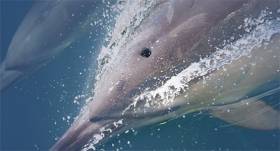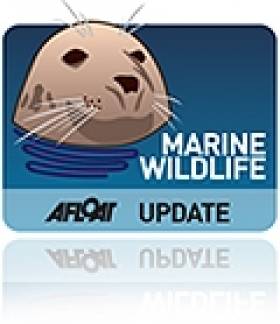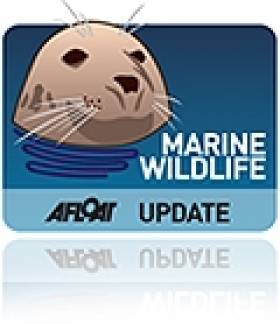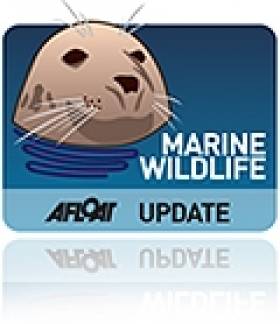Displaying items by tag: Porpoise
First Irish Case of Grey Seal Preying on Harbour Porpoise Is Confirmed
The first case of a grey seal predation on a harbour porpoise in Irish waters has been confirmed, the Irish Whale and Dolphin Group (IWDG) says.
Video of the incident off Clogherhead in Co Louth on Sunday 14 November was submitted to the marine wildlife charity. It appears to show an adult grey seal with a porpoise calf in its mouth and attempting to drown its victim before feeding on it.
Sightings officer Pádraig Whooley said there was “little doubt” as to what was occurring in the footage, which can be seen below. Some viewers may find the video disturbing:
Andy Smith, who was fishing on the pier in Clogherhead when he shot the video, said: “We initially saw the mother and baby about 200m out to sea but about 20 minutes later the seal surfaced with the baby porpoise in its mouth.
“It was quite violent and bloody. Thankfully there were no kids around to witness it. Nature raw in tooth and claw I suppose.”
Whooley added that the incident, while rare, is not without precedent. A paper published in the journal Marine Mammal Science in 2014 offered the first evidence of grey seal predation on harbour porpoise in the English Channel and North Sea.
“However, this behaviour has never before been documented in Irish waters, which is surprising given the large populations we have of both coastal species,” he said.
The incident now opens questions as to whether this is indeed new behaviour from an Irish seal “or one that has simply never before been witnessed or recorded in Ireland”.
In addition, it is not confirmed whether the seal in the video is from an Irish resident population or one that travelled here from the North Sea area.
Whooley also posits: “What are the likely implications at population level for the resident harbour porpoises of Clogherhead and beyond? Especially given that areas like north Co Dublin have some of the highest densities of porpoises in Irish waters.”
Marine Scientists Call For ’Emergency Measures’ To Protect Dolphins & Porpoise In European Waters
Marine scientists have published landmark advice to the European Commission for urgent action to protect dolphins and porpoise in European waters.
According to EU Reporter, the International Council for the Exploration of the Sea (ICES) is advocating for ‘emergency measures’ to prevent bycatch of these vulnerable marine wildlife amid fishing activity in the Bay of Biscay and Baltic Sea.
ICES also insists that such measures, including the closure of some fisheries, would have to be instituted over the long term to ensure the future survival of the species under threat.
The move comes after a network of NGOs, which included the Irish Whale and Dolphin Group, last year called on the Commission to take action against 15 EU member states for failing in their cities to protect cetaceans from bycatch in the North East Atlantic.
EU Reporter has much more on the story HERE.
Marine Traffic Pressures on Scotland’s Cetaceans to be Studied Using Navigation Safety Technology
Electronic navigation safety technology is to be used to study the potential impacts of marine traffic on whale, dolphin and porpoise species off western Scotland in a new season of research expeditions launched by Hebridean Whale and Dolphin Trust this week.
For the first time, scientists and trained volunteers onboard the conservation charity’s specialized research yacht Silurian will use an Automatic Identification System (AIS) transponder to collect detailed data on other vessels’ movements. This will be combined with sightings and underwater acoustic monitoring of cetaceans – the collective name for whales, dolphins and porpoises – to gain new insights into how species are affected by ships’ movements and noise.
AIS – an automatic tracking system that electronically identifies and locates nearby vessels, continuously transmitting details of their identity, position, speed and course – is more commonly used in navigation safety, allowing ships to ‘see’ each other in all conditions.
With marine traffic from a large range of industries growing, known threats or pressures for cetaceans from shipping include ship-strikes – in which vessels accidentally hit whales – and noise pollution from poorly designed or poorly maintained vessels, which can mask out whale sounds used for communication and navigation.
Dr Conor Ryan, Hebridean Whale and Dolphin Trust Science Officer, said: “This innovative approach provides us with an opportunity to enhance our long-term research, which is providing unprecedented insights into the distribution and range of cetaceans in Scotland’s seas, as well as the challenges they face – including the unintentional consequences of human activities.
“The Hebrides may seem like a wilderness, but human impacts on the marine environment are significant – and likely to increase with expansions in marine industries, such as aquaculture and renewable installations. Strengthening scientific understanding is crucial if we are to help industries ensure that their impacts on Scotland’s remarkable whales, dolphins and porpoise populations are minimal.”
The new AIS transponder on Silurian will also allow closer public engagement with the trust’s research expeditions. By using the research vessel’s unique Maritime Mobile Service Identity (MMSI) number 232004280, people will be able to follow Silurian’s progress around Scotland’s west coast in real-time via www.hwdt.org.
Equipping Silurian with AIS technology has been made possible by a grant of £94,000 from the UK Government’s Coastal Communities Fund. This grant has also funded a major refurbishment of the yacht, including an environmentally friendly and long-lasting copper coating for the hull that will ensure the vessel remains seaworthy for the next decade, alongside other activities.
Hebridean Whale and Dolphin Trust – based in Tobermory on the Isle of Mull – is recruiting paying volunteers for its surveys. Between May and October, there will be 12 separate expeditions, each lasting between one and two weeks. This includes two ‘Teen Teams’ reserved for 16-17 year olds.
These volunteers will work and sleep on Silurian, receiving specialist training and working with scientists – conducting visual surveys, acoustic monitoring, and cetacean identification through dorsal fin photography. They will also be able to develop sailing and navigation skills as they visit some of Britain’s most remote and wild corners.
Silurian has been the platform for Hebridean Whale and Dolphin Trust’s unique research programme since 2002, welcoming aboard over 60 volunteers annually, surveying tens of thousands of nautical miles and logging every cetacean encounter made. This year, the yacht will welcome her 800th volunteer aboard. The yacht is also used as a floating classroom for marine conservation education for schoolchildren and students.
Western Scotland’s seas are one of Europe’s most important habitats for cetaceans with 24 of the world’s estimated 92 cetacean species recorded in the region to date. Many of these are national and international conservation priority species.
As well as strengthening knowledge about cetaceans and contributing to recommendations to safeguard them, the trust’s surveys are important because cetaceans are apex predators at the top of the marine food web, and so can act as indicators of the marine environment’s overall health.
The 2016 surveys depart from Tobermory on the Isle of Mull, Kyle of Lochalsh or Ullapool. The new addition of Ullapool as a rendezvous point will allow the trust to carry out more surveys in the remoter corners of its study area. Areas covered depend on the weather but will range from Mull of Kintyre in the south, Cape Wrath in the north and St Kilda in the west.
Participation costs cover boat expenses, accommodation, training, food and insurance, and support the charity’s research. For details, email [email protected], call 01688 302620 or visit www.hwdt.org.
Young Porpoise In Distress In Lough Foyle
#MarineWildlife - The Irish Examiner reports on efforts to save an injured porpoise calf that was found beached on the shores of Lough Foyle yesterday (25 February).
Local people managed to help the young marine mammal, which has a wound on its tail fin, back into deeper water - but strong wind and wave action forced it into the stream of the Bredagh river.
It currently appears to be struggling in the mix of saltwater and freshwater, the latter of which can cause kidney and skin serious problems if cetaceans are exposed to it for extended periods.
The Irish Examiner has more on the story HERE.
Howth Coast Guard picked up a baby Porpoise stranded in shallow water off Portmarnock beach, Dublin yesterday and brought it one kilomretre back out to sea to safety.
Howth Coastguard was requested to assist the Irish Whale and Dolphin Group (IWDG) yesterday afternoon at Portmarnock beach in North Dublin as the youtube video above depicts.
A Coast Guard team from Howth station travelled by boat and jeep to the location and meet with the IWDG representative.
The decision was made to bring the baby mammal who was beached back to the sea in the hope it would swim away.
The boat team lead by coxswain Jaimie Blandford carefully placed the mammal on board and brought it a kilometre out into the open water.
Porpoises are very similar to dolphins but have shorter beaks and are seen in the Irish Sea with the same swimming patterns as dolphins.
The porpoise now named "Fungie Beag" was placed in the water, after some initial hesitation it successfully returned to the water and swam back into the Irish Sea, hopefully returning to its family.
Carcass of Rescued 'Dolphin' Found Beached in Dundalk
#MARINE WILDLIFE - The body of a porpoise washed up on a beach near Dundalk recently is believed to be one of two 'dolphins' rescued from the area just days before.
The Dundalk Democrat reports that the porpoise carcass was discovered by Blackrock Tidy Towns supervisor Pat Rafferty while on a litter patrol of the beach on Tuesday 3 June.
“It must have beached on Monday night sometime, as we would have seen it the day before," he said. "Unfortunately it seems that gulls had got to it.”
Rafferty added: "“Maybe if it had beached during the day we would have been able to rescue it.”
It's thought that the porpoise is one of the two 'dolphins' that were rescued from the shallows by local people and the DunDalk Sub Aqua Team during the Blackrock Raft Race on 25 June.
Harbour porpoises - one of the most common forms of marine wildlife in Ireland - are very similar in apperance to dolphins but have a more triangular dorsal fin and lack the dolphin's beak-like snout.
The Dundalk Democrat has more on the story HERE.




























































